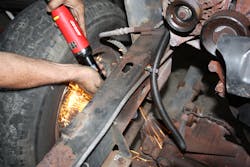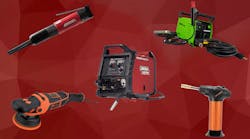Whether looking to increase sales or take advantage of an opportunity within their service area, there are many reasons general repair shops may consider adding collision repair to their list of services. By already having a customer base built up, expanding a shop’s services offers many benefits.
No matter the reason to expand, having the right tools for the job takes priority. Having the right tools that can be of service to both general repair and collision repair applications is key. Multipurpose tools save on space, time, and most importantly, cost.
Although collision repair often requires specific tools and equipment – such as dent pullers or paint stands – a number of power and air tools, hand tools, and specialty tools can be used for both services. Technicians can benefit by understanding the multipurpose value of some key products.
Here is a look at some essential tools for both general repair and collision repair work.
Power and air tools
The right power and air tools can take a lot of grunt work out in both general and collision repairs. From cutting off rusted bolts or damaged door panels, to removing rust or welding seams, being able to move from one repair to another with the same tool is essential for technicians. Shops should consider tools that offer versatility in this category.
“You have to have a cut-off tool,” says Chris Hirsch, director of retail and automotive sales for AIRCAT, a division of Florida Pneumatic. “When [a vehicle] comes in damaged, you’re going to cut material off.”
Mark Kelly, product manager for Milwaukee Tool, agrees that a cut-off tool is ideal. “During service work, sometimes there are situations when technicians need to cut into an exhaust pipe, body panels, or any sort of sheet metal.”
Hirsch recommends shops have an extended reach cut-off tool, a reversible cut-off tool, and a flex head cut-off tool.
The thin cutting disc on an extended reach cut-off tool is ideal for cutting material, axles, and anything bent with a better reach. A reversible cut-off tool allows the user to redirect the sparks by changing the direction of the cutting wheel. A flex head cut-off tool has three positions, enabling the user to cut at an angle, he explains.
A die grinder is another essential tool for both general and collision repairs. A die grinder is used for various functions such as grinding, sanding, cutting, and polishing.
“[A] right angle die grinder is great for removing gaskets on things like oil pans and transmission cases,” Kelly says. “You can also attach a 2-inch cut-off wheel and use it to cut through body panels when needed.”
Milwaukee Tool’s 1/4” Right Angle Die Grinder, No. 2485-20, is optimized for 2” accessories and is able to fit in tight places.
Hirsch also recommends a die grinder, with preference to the right angle die grinder, because they are mostly used with sanding accessories. Right angle die grinders are used for sanding, spot sanding, grinding down welds, and smoothing out and blending materials together, he says.
AIRCAT offers a 1hp Composite Angle Die Grinder, No. 6265, which comes with both 2” and 3” backing pads.
In addition to cut-off tools and die grinders, Hirsch also lists air saws (for quick straight and/or curved cuts) and sanders, both palm and block sanders, as essential tools for both general and collision repairs.
Kelly recommends technicians add an impact wrench, impact ratchet, and a polisher to the list of essential tools as well.
Hand and specialty tools
Similar to general repair, collision repair work requires technicians to access and remove parts on vehicles without damaging the surrounding area. For collision repairs, tools that remove clips, molding, trim, and panels are especially important.
“It is important to have tools that are versatile enough to do both types of vehicle repair, and tools that can be used for multiple purposes,” says Eddie Lisle, sales manager at Lisle Corporation. “For instance, there are various types of plastic fasteners and clips found on vehicles today that [may] need to be removed or replaced.”
Lisle offers a variety of tools that can pry, separate, turn, twist, and grip plastic fasteners and clips, for example, at different angles that are difficult to remove. Products include Lisle’s Plastic Fastener Remover, No. 35260; Double Ended Clip Lifter, No. 35460; and Plastic Clip Removal Pliers, No. 42810.
“These tools were made so they won’t mark, scratch, dent, or damage surfaces on the vehicle,” Lisle adds. “They were [also] designed specifically so you don’t have to resort to using a screwdriver or something else that won’t work as well or that could possibly damage the vehicle.”
Mueller-Kueps agrees that tools needed to remove plastic clips and panels are essential.
“To properly service both collision and general repair customers, a technician should have some sort of panel and clip remover to access behind door or overhead panels,” says Andre Van Lagen, sales manager, North America at Mueller-Kueps.
Mueller-Kueps offers a 5-pc Clip Lifter Set, No. 277 015, that is designed to quickly and easily remove plastic fasteners, plastics clips, upholstery, and door panels. The set is made from durable steel with a high-quality polished chrome finish.
Van Lagen would also recommend having scrapers in the shop to remove glue, paint, stickers, or dirt. He suggests Mueller-Kueps’ Quick-Lock Razor Scraper, No. 268 420, that features a quick-lock safety release mechanism and comes with five steel and five plastic blades.
Aside from specialty tools, hand tools such as pry bars, locking pliers, ratchets, and socket and wrench sets should be easily accessible.
“These are all core hand tools designed for a wide variety of jobs,” Milwaukee Tool’s Kelly says. “With these tools, technicians will be able to tackle the majority of jobs they come into contact with during collision repair.”
Examples he provides include Milwaukee Tool’s 32-pc Ratchet and Socket Set, No. 48-22-9008; 4-pc Pry Bar Set, No. 48-22-9214; and 10-pc Torque Lock Set, No. 48-22-3690.
Conclusion
Tools that can pull double-duty and not only be used from one repair job to the next, but also go from general repair work to a collision-specific job, are vital. Multipurpose tools are essential tools, saving shops and technicians time, space, and cost.


